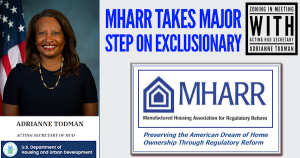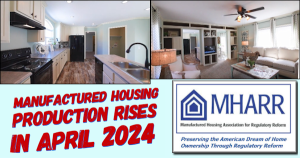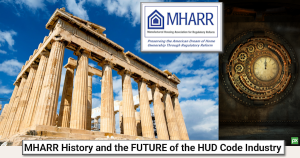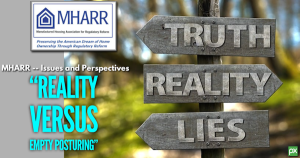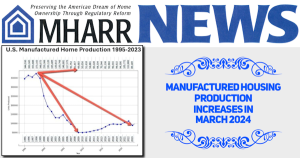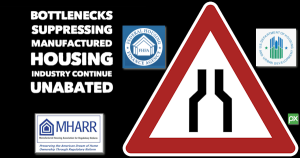“Discriminatory Manufactured Home Energy Regulation Looms Once Again”
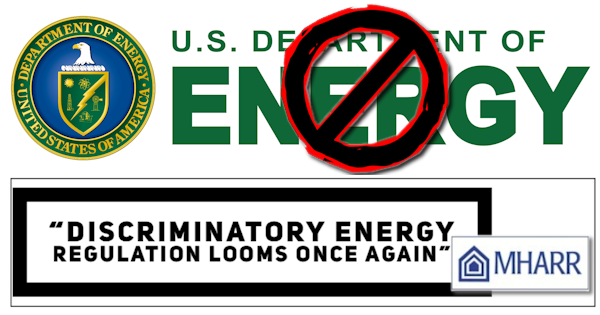
Like a monster in a B-Grade horror movie that refuses to die, the specter of excessive, discriminatory and extremely-costly federal manufactured housing energy “conservation” standards has emerged once again, this time courtesy of energy special interests and a distinctly un-Trump-like cave-in by the leadership at the U.S. Department of Energy (DOE). As a result, the industry finds itself, once again, faced with the prospect of extreme energy-based regulatory burdens that are not only unnecessary, as shown by extensive federal data, but will simultaneously exclude millions of Americans from the dream of homeownership, directly contrary to President Trump’s affordable housing policies and the express mandate of the White House Council on the Elimination of Regulatory Barriers to Affordable Housing.
The immediate source of this looming threat is a court order issued at the end of 2019 in a federal case filed by the environmental activists at the Sierra Club. The Sierra Club sued former DOE Secretary Rick Perry in the U.S. District Court for the District of Columbia in late 2017, seeking an order compelling DOE to proceed with the adoption of manufactured housing energy standards under section 413 of the Energy Independence and Security Act of 2007 (EISA). DOE moved to have the case dismissed, claiming that the Sierra Club lacked legal “standing” to assert such a claim on behalf of its members. The court, however (in the person of Judge Emmet Sullivan, a Bill Clinton appointee), denied that motion in an order entered on March 12, 2019.
This set up a potential trial on the merits of the case, which MHARR strongly urged DOE to undertake because of the fundamentally corrupted rulemaking process that led to both DOE’s 2016 proposed energy standards rule and the Department’s 2018 revised manufactured housing energy proposal, set out in a Notice of Data Availability (NODA). More on this in a moment. DOE, however, in a practice that was all too commonplace during the Obama Administration – and has inexplicably been carried over to the Trump Administration in this case by some at DOE and the Department of Justice (DOJ) (which ostensibly “defended” DOE in this case) – folded like a cheap suit and agreed to a “Consent Order” which requires DOE to propose manufactured housing energy standards under EISA no later than May 14, 2021, and to adopt final manufactured housing energy standards no later than February 14, 2022.
Whether the standards proposed by DOE under these court-ordered deadlines will be the 2016 proposed standards, the 2018 NODA standards, some variant thereof, or something completely different, is unclear and, indeed, unknown at the current time. Suffice it to say, however, that MHARR has already stressed to DOE in writing that any proposed standards that are linked to, or in any way derived from DOE’s previous fatally-defective rulemaking process in this matter, are – and will be – totally unacceptable and will be vigorously opposed through any and all available means. MHARR, rather, as it has previously asserted, maintains that any new energy standards rulemaking – if pursued at all — must go “back to the drawing board” and begin-over from the start, with a totally new process that is not in any waytainted or impacted by the illegitimate and invalid DOE “negotiated rulemaking” proceeding that led to both the 2016 proposed rule and the 2018 DOE NODA (as established by MHARR in its September 2018 NODA comments).
While the Sierra Club lawsuit, then, is the immediate cause for the impending revival of extreme and discriminatory DOE manufactured housing energy standards which MHARR has previously beat-back time and time-again – and had successfully stifled until they were revived by staff of the Manufactured Housing Institute (see below) — this entire matter is a prime example of a self-inflicted industry wound. And while the full story of the corrupted “negotiated rulemaking” process that followed is set out in detail in comprehensive MHARR regulatory comments filed with DOE in August 2016 and September 2018 (both of which can be found at MHARR’s internet website, www.manufacturedhousingassociation.org, it would be useful to highlight here just some of the deceitful tactics utilized by DOE and its allies in order to advance extreme and unnecessary manufactured housing energy regulation.
Put simply, DOE energy regulation, as of early 2014 – well beyond the five-year EISA deadline for the adoption of DOE manufactured housing energy standards — was going exactly nowhere. MHARR — which had been successful in attaching language to EISA section 413 requiring public notice and comment on any DOE-proposed energy standards andprior review by the Manufactured Housing Consensus Committee (MHCC) — through pressure on HUD, DOE and the MHCC, was able to keep new federal energy standards stalled at DOE, which had gone through multiple fits and starts on a “draft” proposed rule. In fact, the entire issue had all but disappeared from the regulatory and MHCC landscape until the then-MHI Regulatory Affairs Vice President, together with specific named energy special interests, in May 14, 2014 and May 28, 2014 communications to DOE, revived the entire matter, calling for DOE to undertake a “negotiated rulemaking” to “develop” federal manufactured housing energy standards pursuant to EISA, with “a tight meeting schedule” and “a minimum [number] of meetings” despite the highly-technical and cost-intensive nature of those regulations. As a result, a DOE energy rulemaking that had been stagnant and, as later learned by MHARR, had produced a “draft” proposed rule that had been rejected by the Office of Management and Budget’s Office of Information and Regulatory Affairs (OIRA), was effectively re-started and revitalized with the help of part of the industry.
What then followed – as was extensively reported by MHARR at the time – was a sham “negotiated rulemaking” dominated by MHI-member participants and energy special interests, which utilized non-public data inputs to produce a “term sheet” incorporating supposedly “new” recommended energy standards after only a few months of highly-truncated deliberations. What was never disclosed by DOE, however, and had to be unearthed by MHARR through multiple Freedom of Information Act (FOIA) requests, was a pattern of deceit and manipulation of the supposed “negotiated rulemaking” process by DOE, to produce the result that DOE officials and its special interest allies wanted.
This manipulation included, but was not limited to: (1) collusion by DOE with its special interest allies to produce a “draft” manufactured housing energy standards rule in 2011 with no public input; (2) the “impermissible” leak of that “draft” proposed rule (as characterized by DOE’s Office of General Counsel) to DOE’s special interest allies; (3) failure to disclose that “draft” rule or inputs received from special interest allies; (4) failure to disclose the “impermissible” leak of the 2011 draft rule despite requests by MHARR; (5) failure to disclose either the existence of the 2011 “draft” rule or its rejection by OIRA; (6) failure to disclose a directive by OIRA to “start-over” the entire DOE manufactured housing energy rulemaking process; (7) failure to disclose surreptitious coordination between DOE and its special interest allies to conduct a contrived “negotiated rulemaking” process in order to effectively circumvent OIRA’s “start-over” directive; and (8) failure to disclose surreptitious DOE coordination with its special interest allies to establish a “negotiated rulemaking” working group dominated and effectively controlled by “insider” selective leak recipients in order to produce a proposed rule consistent with DOE’s desired outcome.
And, just in case its blatant manipulation of the so-called “negotiated rulemaking” process – stacked with DOE special interest allies – did not work, DOE, in a plot described in various public documents, worked with the part of the industry to manipulate industry opinion in favor of national DOE energy standards for manufactured homes. This was fueled by the award, by DOE and various DOE sub-entities, of more than $1 million in supposed “research” contracts to an MHI-affiliated “research” organization.
In the end, the DOE “negotiated rulemaking” working group wound-up approving a “term sheet” of proposed manufactured housing energy standards that, according to MHARR calculations provided to the working group, would have added as much as $6,000.00 to the retail cost of a new multi-section manufactured home – costs that (as later confirmed by the George Washington University Regulatory Studies Center) could not begin to be recovered by a manufactured homeowner over the typical ownership period of a new HUD Code manufactured home. And that astronomical figure did not include costs related to testing, enforcement and regulatory compliance, because standards relating to those matters were not addressed or developed by DOE until after its 2016 proposed rule was published. Consequently, the cost of any final rule based on the working group’s term sheet, would have far exceeded even the $6,000.00 per home cost estimated by MHARR. Yet, astoundingly, only MHARR voted against the working group’s recommended term sheet, while MHI and all of its members voted to approve the recommended standards (with just one abstention).
The 2016 proposed DOE standards, accordingly, are the product of a fundamentally tainted standards development process, and a woeful illustration of what can occur when part of the industry says one thing, but does another. Further, they were not, have not and cannot ever be “cured” by any subsequent means or measure(s). As a result, they must neverbe revived or used as the basis for any action by DOE on this matter. And, insofar as the 2018 NODA proposal, by its express terms, was based on “data” developed and “analyzed” as part of the tainted “negotiated rulemaking” process, that proposal, as well, is fundamentally and inherently flawed and cannot form the basis for any legitimate standards proposal going forward.
And all of this does not even begin to address the overriding fact that, according to U.S. Census Bureau data, median monthly energy costs for HUD Code manufactured homes, constructed in accordance with existing HUD standards – including existing HUD energy standards – are already lower than site-built homes for both heating oil and piped natural gas, and only slightly higher for electricity. DOE manufactured housing energy standards, accordingly, would be a purported solution (and not even a good or cost-effective one at that) in search of a “problem” that simply does not exist.
Any revival of this proceeding, therefore, whether ordered by a court or not, would be totally inconsistent with the regulatory reform policies of President Trump and in violation of the regulatory reform Executive Orders (EOs) which have been the hallmark of his administration in the regulatory arena (including Executive Orders 13771 and 13777, and EO 13878, which created the White House Council on Eliminating Regulatory Barriers to Affordable Housing). DOE’s senior leadership, consequently, instead of following the feckless lead of an ineffectual and “swamp”-infested DOJ and Washington, D.C. United States Attorney’s office – and DOE career bureaucrats — regarding this matter, should instead comply with and fully honor the regulatory reform policies of the President and his Administration to terminate the DOE manufactured housing energy standards travesty that has played out for more than a decade.
Meanwhile, the entire industry needs to shake off the impact of years-worth of misinformation spread by DOE and its special interest allies regarding manufactured housing energy standards, and firmly reject the entire concept of discriminatory DOE manufactured housing energy standards that will cause major harm to both the industry and American consumers of affordable housing. MHARR, for its part, has already communicated with new DOE Secretary Dan Brouilette, calling on DOE to put aside this travesty and to address the issue of manufactured housing energy standards as a regulatory reform issue. Put simply, manufactured homes are already energy efficient. The last thing that either consumers or the industry needs (as noted already by the MHCC) is high-cost energy standards with regulatory compliance costs that cannot be recovered by homeowners over the ownership period of the typical mainstream HUD Code home.
Mark Weiss
MHARR is a Washington, D.C.-based national trade association representing the views and interests of independent producers of federally-regulated manufactured housing.
“MHARR-Issues and Perspectives” is available for re-publication in full (i.e., without alteration or substantive modification) without further permission and with proper attribution to MHARR.
Like a monster in a B-Grade horror movie that refuses to die, the specter of excessive, discriminatory and extremely-costly federal manufactured housing energy “conservation” standards has emerged once again, this time courtesy of energy special interests and a distinctly un-Trump-like cave-in by the leadership at the U.S. Department of Energy (DOE). As a result, the industry finds itself, once again, faced with the prospect of extreme energy-based regulatory burdens that are not only unnecessary, as shown by extensive federal data, but will simultaneously exclude millions of Americans from the dream of homeownership, directly contrary to President Trump’s affordable housing policies and the express mandate of the White House Council on the Elimination of Regulatory Barriers to Affordable Housing.
The immediate source of this looming threat is a court order issued at the end of 2019 in a federal case filed by the environmental activists at the Sierra Club. The Sierra Club sued former DOE Secretary Rick Perry in the U.S. District Court for the District of Columbia in late 2017, seeking an order compelling DOE to proceed with the adoption of manufactured housing energy standards under section 413 of the Energy Independence and Security Act of 2007 (EISA). DOE moved to have the case dismissed, claiming that the Sierra Club lacked legal “standing” to assert such a claim on behalf of its members. The court, however (in the person of Judge Emmet Sullivan, a Bill Clinton appointee), denied that motion in an order entered on March 12, 2019.
This set up a potential trial on the merits of the case, which MHARR strongly urged DOE to undertake because of the fundamentally corrupted rulemaking process that led to both DOE’s 2016 proposed energy standards rule and the Department’s 2018 revised manufactured housing energy proposal, set out in a Notice of Data Availability (NODA). More on this in a moment. DOE, however, in a practice that was all too commonplace during the Obama Administration – and has inexplicably been carried over to the Trump Administration in this case by some at DOE and the Department of Justice (DOJ) (which ostensibly “defended” DOE in this case) – folded like a cheap suit and agreed to a “Consent Order” which requires DOE to propose manufactured housing energy standards under EISA no later than May 14, 2021, and to adopt final manufactured housing energy standards no later than February 14, 2022.
Whether the standards proposed by DOE under these court-ordered deadlines will be the 2016 proposed standards, the 2018 NODA standards, some variant thereof, or something completely different, is unclear and, indeed, unknown at the current time. Suffice it to say, however, that MHARR has already stressed to DOE in writing that any proposed standards that are linked to, or in any way derived from DOE’s previous fatally-defective rulemaking process in this matter, are – and will be – totally unacceptable and will be vigorously opposed through any and all available means. MHARR, rather, as it has previously asserted, maintains that any new energy standards rulemaking – if pursued at all — must go “back to the drawing board” and begin-over from the start, with a totally new process that is not in any waytainted or impacted by the illegitimate and invalid DOE “negotiated rulemaking” proceeding that led to both the 2016 proposed rule and the 2018 DOE NODA (as established by MHARR in its September 2018 NODA comments).
While the Sierra Club lawsuit, then, is the immediate cause for the impending revival of extreme and discriminatory DOE manufactured housing energy standards which MHARR has previously beat-back time and time-again – and had successfully stifled until they were revived by staff of the Manufactured Housing Institute (see below) — this entire matter is a prime example of a self-inflicted industry wound. And while the full story of the corrupted “negotiated rulemaking” process that followed is set out in detail in comprehensive MHARR regulatory comments filed with DOE in August 2016 and September 2018 (both of which can be found at MHARR’s internet website, www.manufacturedhousingassociation.org, it would be useful to highlight here just someof the deceitful tactics utilized by DOE and its allies in order to advance extreme and unnecessary manufactured housing energy regulation.
Put simply, DOE energy regulation, as of early 2014 – well beyond the five-year EISA deadline for the adoption of DOE manufactured housing energy standards — was going exactly nowhere. MHARR — which had been successful in attaching language to EISA section 413 requiring public notice and comment on any DOE-proposed energy standards andprior review by the Manufactured Housing Consensus Committee (MHCC) — through pressure on HUD, DOE and the MHCC, was able to keep new federal energy standards stalled at DOE, which had gone through multiple fits and starts on a “draft” proposed rule. In fact, the entire issue had all but disappearedfrom the regulatory and MHCC landscape until the then-MHI Regulatory Affairs Vice President, together with specific named energy special interests, in May 14, 2014 and May 28, 2014 communications to DOE, revived the entire matter, calling for DOE to undertake a “negotiated rulemaking” to “develop” federal manufactured housing energy standards pursuant to EISA, with “a tight meeting schedule” and “a minimum [number] of meetings” despite the highly-technical and cost-intensive nature of those regulations. As a result, a DOE energy rulemaking that had been stagnant and, as later learned by MHARR, had produced a “draft” proposed rule that had been rejected by the Office of Management and Budget’s Office of Information and Regulatory Affairs (OIRA), was effectively re-started and revitalized with the help of part of the industry.
What then followed – as was extensively reported by MHARR at the time – was a sham “negotiated rulemaking” dominated by MHI-member participants and energy special interests, which utilized non-public data inputs to produce a “term sheet” incorporating supposedly “new” recommended energy standards after only a few months of highly-truncated deliberations. What was never disclosed by DOE, however, and had to be unearthed by MHARR through multiple Freedom of Information Act (FOIA) requests, was a pattern of deceit and manipulation of the supposed “negotiated rulemaking” process by DOE, to produce the result that DOE officials and its special interest allies wanted.
This manipulation included, but was not limited to: (1) collusion by DOE with its special interest allies to produce a “draft” manufactured housing energy standards rule in 2011 with no public input; (2) the “impermissible” leak of that “draft” proposed rule (as characterized by DOE’s Office of General Counsel) to DOE’s special interest allies; (3) failure to disclose that “draft” rule or inputs received from special interest allies; (4) failure to disclose the “impermissible” leak of the 2011 draft rule despite requests by MHARR; (5) failure to disclose either the existence of the 2011 “draft” rule or its rejection by OIRA; (6) failure to disclose a directive by OIRA to “start-over” the entire DOE manufactured housing energy rulemaking process; (7) failure to disclose surreptitious coordination between DOE and its special interest allies to conduct a contrived “negotiated rulemaking” process in order to effectively circumvent OIRA’s “start-over” directive; and (8) failure to disclose surreptitious DOE coordination with its special interest allies to establish a “negotiated rulemaking” working group dominated and effectively controlled by “insider” selective leak recipients in order to produce a proposed rule consistent with DOE’s desired outcome.
And, just in case its blatant manipulation of the so-called “negotiated rulemaking” process – stacked with DOE special interest allies – did not work, DOE, in a plot described in various public documents, worked with the part of the industry to manipulate industry opinion in favor of national DOE energy standards for manufactured homes. This was fueled by the award, by DOE and various DOE sub-entities, of more than $1 million in supposed “research” contracts to an MHI-affiliated “research” organization.
In the end, the DOE “negotiated rulemaking” working group wound-up approving a “term sheet” of proposed manufactured housing energy standards that, according to MHARR calculations provided to the working group, would have added as much as $6,000.00 to the retail cost of a new multi-section manufactured home – costs that (as later confirmed by the George Washington University Regulatory Studies Center) could not begin to be recovered by a manufactured homeowner over the typical ownership period of a new HUD Code manufactured home. And that astronomical figure did not include costs related to testing, enforcement and regulatory compliance, because standards relating to those matters were not addressed or developed by DOE until after its 2016 proposed rule was published. Consequently, the cost of any final rule based on the working group’s term sheet, would have far exceeded even the $6,000.00 per home cost estimated by MHARR. Yet, astoundingly, only MHARR voted against the working group’s recommended term sheet, while MHI and all of its members voted to approve the recommended standards (with just one abstention).
The 2016 proposed DOE standards, accordingly, are the product of a fundamentally tainted standards development process, and a woeful illustration of what can occur when part of the industry says one thing, but does another. Further, they were not, have not and cannot ever be “cured” by any subsequent means or measure(s). As a result, they must neverbe revived or used as the basis for any action by DOE on this matter. And, insofar as the 2018 NODA proposal, by its express terms, was based on “data” developed and “analyzed” as part of the tainted “negotiated rulemaking” process, that proposal, as well, is fundamentally and inherently flawed and cannot form the basis for any legitimate standards proposal going forward.
And all of this does not even begin to address the overriding fact that, according to U.S. Census Bureau data, median monthly energy costs for HUD Code manufactured homes, constructed in accordance with existing HUD standards – including existing HUD energy standards – are already lower than site-built homes for both heating oil and piped natural gas, and only slightly higher for electricity. DOE manufactured housing energy standards, accordingly, would be a purported solution (and not even a good or cost-effective one at that) in search of a “problem” that simply does not exist.
Any revival of this proceeding, therefore, whether ordered by a court or not, would be totally inconsistent with the regulatory reform policies of President Trump and in violation of the regulatory reform Executive Orders (EOs) which have been the hallmark of his administration in the regulatory arena (including Executive Orders 13771 and 13777, and EO 13878, which created the White House Council on Eliminating Regulatory Barriers to Affordable Housing). DOE’s senior leadership, consequently, instead of following the feckless lead of an ineffectual and “swamp”-infested DOJ and Washington, D.C. United States Attorney’s office – and DOE career bureaucrats — regarding this matter, should instead comply with and fully honor the regulatory reform policies of the President and his Administration to terminate the DOE manufactured housing energy standards travesty that has played out for more than a decade.
Meanwhile, the entire industry needs to shake off the impact of years-worth of misinformation spread by DOE and its special interest allies regarding manufactured housing energy standards, and firmly reject the entire concept of discriminatory DOE manufactured housing energy standards that will cause major harm to both the industry and American consumers of affordable housing. MHARR, for its part, has already communicated with new DOE Secretary Dan Brouilette, calling on DOE to put aside this travesty and to address the issue of manufactured housing energy standards as a regulatory reform issue. Put simply, manufactured homes are already energy efficient. The last thing that either consumers or the industry needs (as noted already by the MHCC) is high-cost energy standards with regulatory compliance costs that cannot be recovered by homeowners over the ownership period of the typical mainstream HUD Code home.
Mark Weiss
MHARR is a Washington, D.C.-based national trade association representing the views and interests of independent producers of federally-regulated manufactured housing.
“MHARR-Issues and Perspectives” is available for re-publication in full (i.e., without alteration or substantive modification) without further permission and with proper attribution to MHARR.





